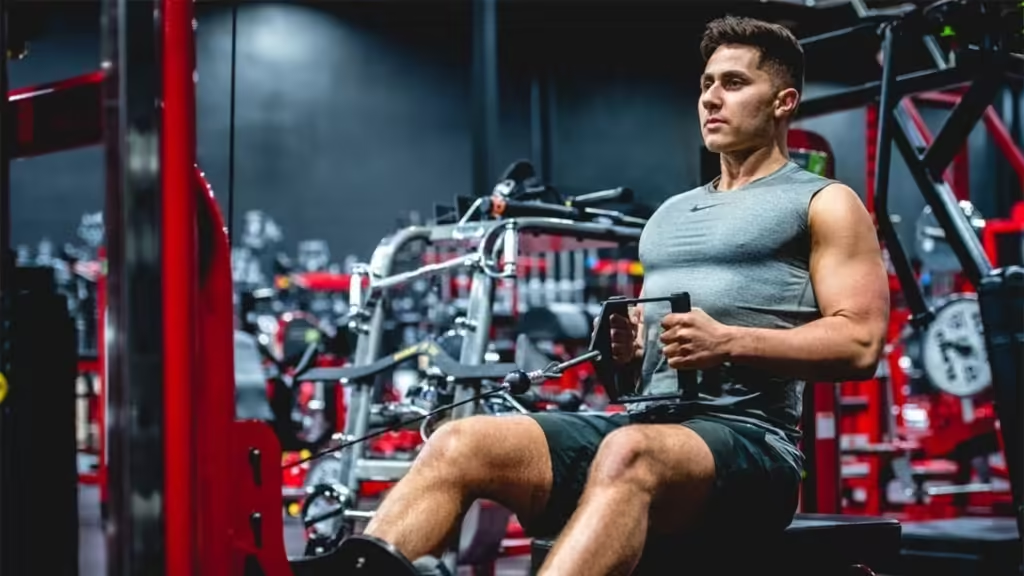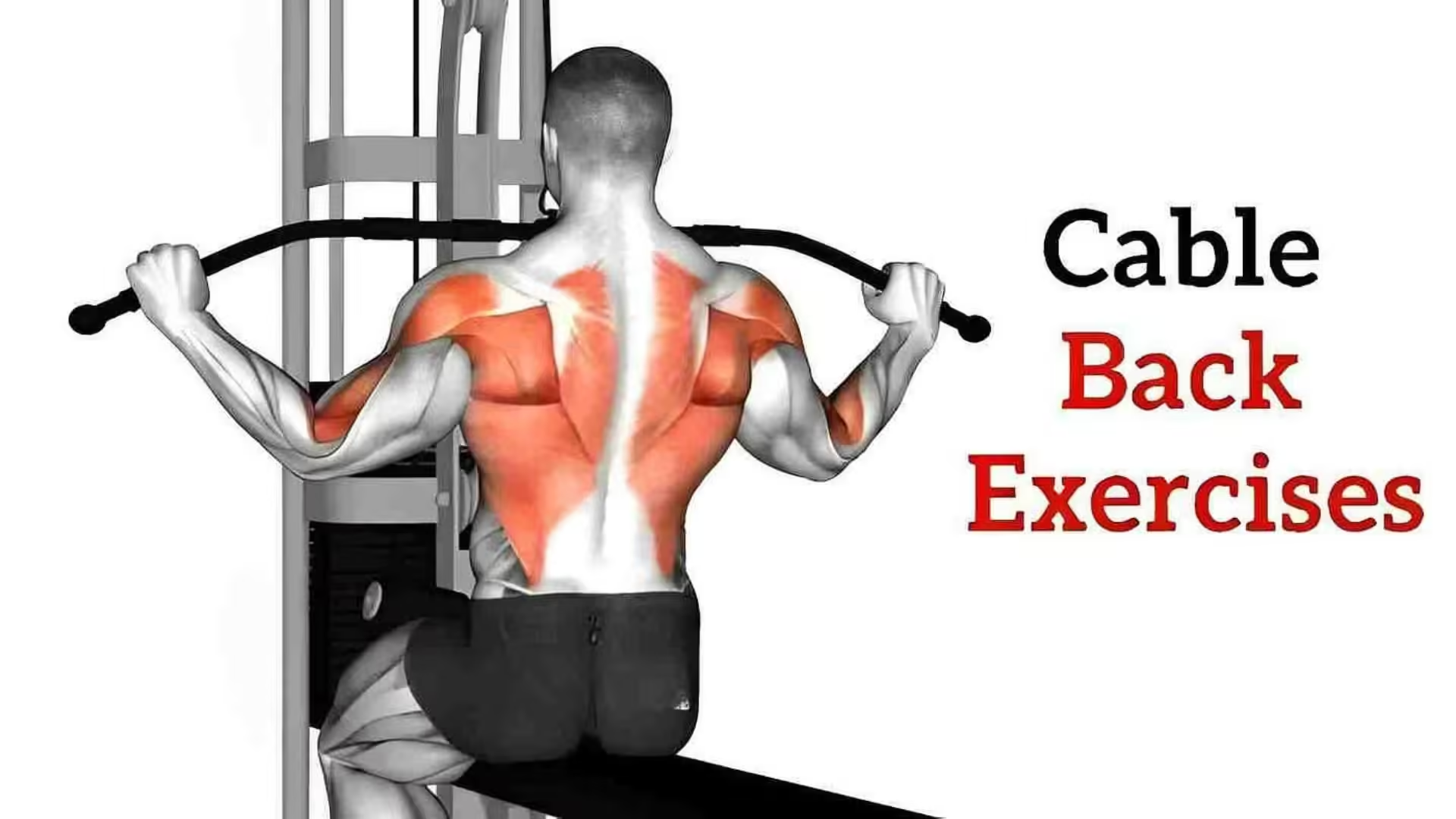Hello, Beautiful People! Do you want to alleviate your strength, stability, and posture? The solution is cable exercises that focus the back due to their ability to provide tension throughout the movement.
Contrary to free weights, cables allow for a broad range of motion. It can isolate specific muscles with accuracy. In this blogpost, we’ll discuss the best cable exercises to build a powerful back. We’ll also discuss techniques to boost up your workout.
Doesn’t matter you’re a starter or a professional athlete, including these exercises can increase your overall fitness.
Let’s get going!
Cable Exercises For Back
| Exercise Number | Exercise Name |
|---|---|
| 1 | Lat Pulldowns |
| 2 | Seated Cable Rows |
| 3 | Cable Deadlifts |
| 4 | Face Pulls |
| 5 | Cable Pull-Throughs |
| 6 | Straight Arm Pulldowns |

Lat Pulldowns
Lat Pulldowns focuses on the latissimus dorsi muscles. This is necessary for a wide, strong back. This exercise helps in building upper body strength and improve posture.
How to Perform
- Sit at the lat pulldown machine and adjust the thigh pad to make your legs secure. Select the suitable weight.
- Grasp the bar with a broad grip.
- Pull the bar down towards your chest and keep your back straight and elbows close to your body.
- Slowly return the bar to the starting point.
Common Mistakes to Avoid
- Using more weight can cause poor form.
- Bending back unnecessarily to pull the bar down.
Variations:
- Wide Grip Pulldowns: Focuses the outer lats.
- Close Grip Pulldowns: Focuses the lower lats and middle back.
- Single-Arm Pulldowns: Focuses on unilateral strength and muscle imbalances.
Seated Cable Rows
Seated Cable Rows focuse the mid-back. This exercise helps to build back thickness and posture.
How to Perform
- Sit at the cable row machine with your feet placed on the footrests.
- Grasp the handle with a neutral grip.
- Pull the handle towards your torso now squeeze your shoulder blades together.
- Slowly expand your arms to return to the starting position.
Common Mistakes to Avoid:
- Using excessive weight can cause rounding of the back.
- Allowing the shoulders to shrug unnecessarily.
Variations:
- Wide Grip Rows: Focuses the upper back and rear deltoids.
- Narrow Grip Rows: Focuses on the lower lats and middle back.
- One-Arm Rows: Points muscle imbalances.
The following video is about cable exercises:
Cable Deadlifts
Cable Deadlifts are traditional deadlift that focuses the:
- Lower back
- Glutes
- Hamstrings.
How to Perform
- Attach a low pulley to the cable machine and select a suitale weight. Stand with your face towards the machine.
- Grasp the handle with both hands and keep your arms fully expanded.
- With a straight back and little bend in your knees, turn at your hips to lower the weight towards the floor.
- Maintain a controlled motion and avoid unrestricted arching of the back.
Common Mistakes to Avoid
- Rounding the back during the lift can cause injury.
- Using the arms to lift the weight rather than focus on the lower back.
Variations
- Single-Leg Deadlifts: Challenges balance and seperates each side of the lower body.
- Sumo Stance Deadlifts: Focuses on the inner thighs with a broader stance.
Face Pulls
Face Pulls are necessary exercise that focuses on the:
- Posterior deltoids
- Upper back
- Shoulder muscles.
This exercise is important for making posture better. It increases shoulder stability, making it a go-to move. Face Pulls are normally done using a cable machine with a rope attachment They can also be done with resistance bands.
How to Perform Face Pulls
- Connect a rope handle to a high pulley on a cable machine.
- Stand with your face towards the machine with your feet and shoulder width at a distance.
- Grasp the ends of the rope with both hands. Your palms must face each other.
- Step back a little to create tension in the cable. Make sure your arms are expanded in front of you.
- Involve your core, and keep your back straight.
- Pull the rope towards your face.
- Keep your elbows high.
- Compress your shoulder blades together at the peak of the movement. Make sure that the back muscles are involved.
- Slowly return to the starting position, fully expanding your arms without losing tension in the cable.
- Try for 3 sets of 10-15 repetitions. Focus on measured movements to maximize muscle involvement.
Best Cable Exercises for Back
To applause Face Pulls, including different cable exercises can help you build a strong back. Following are some of the best cable exercises for back:
1. Cable Lat Pulldowns: Sit down on a lat pulldown machine. Now grasp the bar with a broad grip, and pull it down towards your chest. Focus on compressing your lats and control the bar on the way up. It focuses on:
- Latissimus dorsi
- Middle back
- Biceps.
2. Seated Cable Rows: In this exercise, you need to sit on a rowing machine. Now, grasp the handle and pull it towards your abdomen. Compress your shoulder blades together at the end of the movement. It focuses on:
- Rhomboids
- Trapezius
- Lats
- Rear deltoids.
3. Cable Straight-Arm Pulldowns: Stand facing the cable machine with a straight bar that is attached to the high pulley. With your arms expanded, pull the bar down towards your thighs and keep your arms straight. It focuses on:
- Lats
- Upper back.
4. Single-Arm Cable Rows: In this exercise, you have to stand while facing cable machine. Grasp the handle with one hand and move it towards your hip. This exercise focuses on;
- Lats
- Traps
- Rear deltoids.
5. Cable Shrugs: Stand with your back to the cable machine. Now, grasp the handles, and move your shoulders up towards your ears. It focuses on trapezius muscles.
Including Face Pulls and the mentioned cable exercises into your routine will help build a balanced and strong back. This will make posture better and reduce the risk of injury. Consistency and proper form are main factors to maximizing the advantages of these exercises.
Cable Pull-Throughs
Cable Pull-Throughs are the best exercise for focusing the:
- Posterior chain
- Lower back
- Glutes
- Hamstrings.
How to Perform
- Attach a single handle to a low pulley on the cable machine.
- Grab the handle with both hands, keeping your arms expanded and your back straight.
- Rest at your hips to pull the handle through your legs, thrusting your hips forward as you stand up.
- Slowly reverse the movement, keep control as you come back to the starting point.
Common Mistakes to Avoid
- Use your back to lift the weight instead of involving your glutes and hamstrings.
- Allowing unnecessary forward lean during the exercise.
Variations:
- Single-Leg Pull-Throughs: Increases balance and unilateral strength.
- Sumo Stance Pull-Throughs: Adjusts the focus to the inner thighs and glutes.
Use it or Lose it | EP. 20 | TRUNK ROTATION
TRUNK ROTATION benefits:
✅Low back flexibility
✅decrease thoracic tension
✅improve posture and movement
•#motivation #exercise #docprince #lowback #lowbackpain #painrelief #qualityoflife #trunk #rotation #tightness #posture pic.twitter.com/Pk297Bi13o— Dr Prince (@DocPrinceDC) August 14, 2024
Straight Arm Pulldowns
The last but not the least is Straight Arm Pulldowns. This is the main exercise for separating the latissimus dorsi muscles. This helps to improve back definition and strength. It focuses on the upper back and lats.
How to Perform
- Attach a rope to the high pulley on the cable machine. You should stand with your feet shoulder at a distance. And your knees little curved.
- Hold the bar with a grip and keep your arms fully expanded.
- Pull the bar down in a controlled motion and keep your arms straight.
- Slowly arrive the bar back to the starting position, maintain control, and avoid unrestricted swinging.
Common Mistakes to Avoid
- Bending the elbows during the movement. This reduces effectiveness.
- Using excessive weight, which can cause injury.
Variations
- Single-Arm Pulldowns: Allows for a focus on each side of the back individually.
- Different Attachments: Use a rope to change the grip and focus the lats from different angles.
Conclusion
Including cable exercises into your workout routine is a powerful way to develop a strong back. Each exercise focuses on particular muscles. It takes part in back strength and stability.
By understanding proper form, you can boost up your workouts. You can also fix muscle imbalances. If you’re aiming for better posture or a more sculpted physique, these cable exercises provide effectiveness.
Include these movements in your training to build a resilient back that supports your functional fitness and aesthetic goals.
Let me know in the comments below how do you do cable exercises?
FAQ
1. How many times should I do cable back exercises?
Try to include cable back exercises in your routine 2-3 times per week. This allows for recovery and muscle growth.
2. Can starters do these exercises?
Yes, starters can do these exercises with lighter weights. If you’re a beginner, start with basic and gradually increase weight and intensity as you become more experienced.
3. What are the advantages of using cables?
- Cables provide constant tension throughout the movement
- They increase muscle engagement
- They provide broad range of motion.
4. How can I avoid common mistakes while performing these exercises?
To avoid common mistakes, focus on maintaining proper form. Avoid using uncontrolled weight and make sure you involve the focused muscles.
5. How do I include these exercises into a balanced workout routine?
Combine these cable back exercises with other strength training exercises. Try for a balanced routine that includes exercises for:
- Chest
- Legs
- Arms
- Core.




